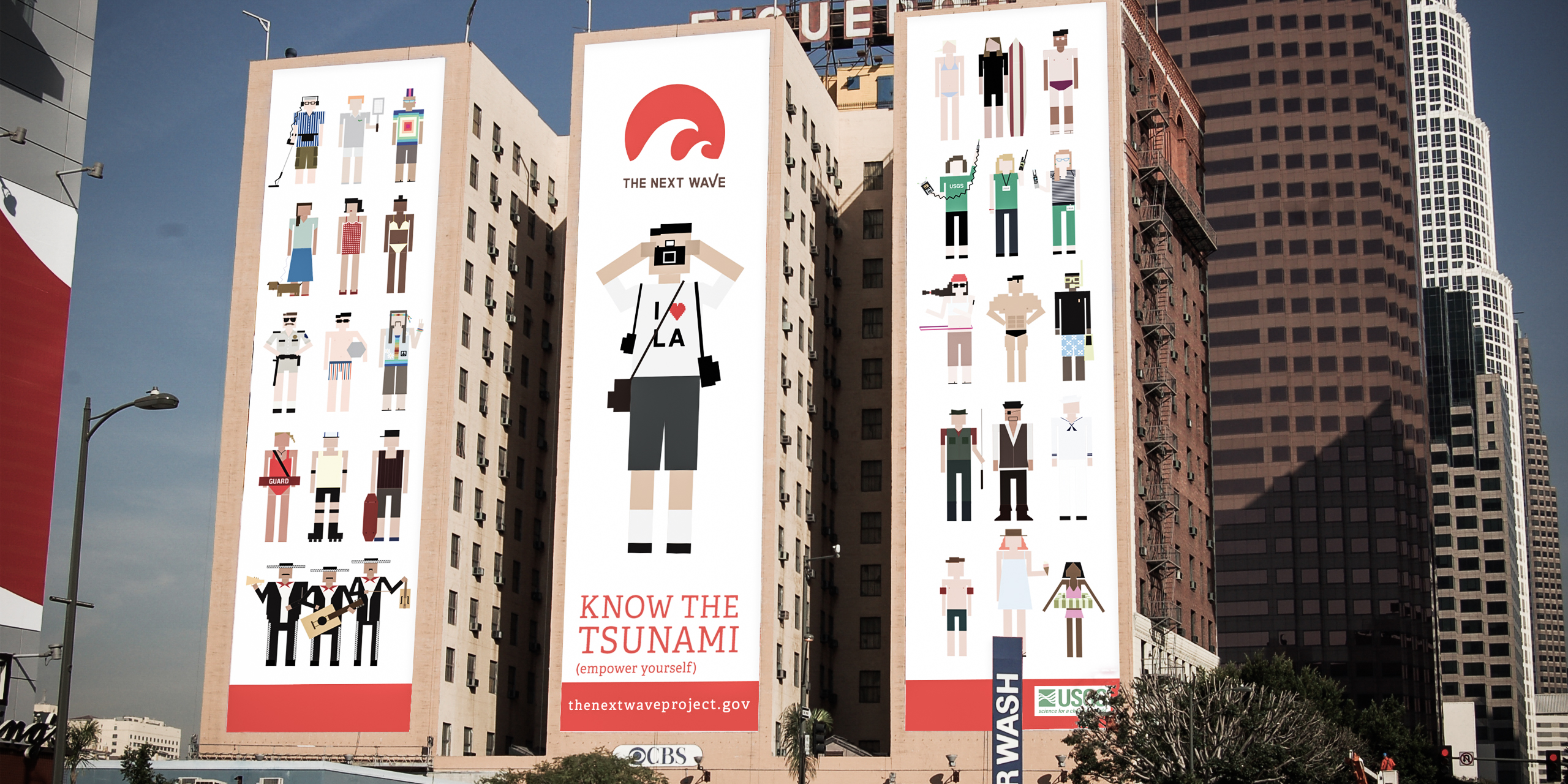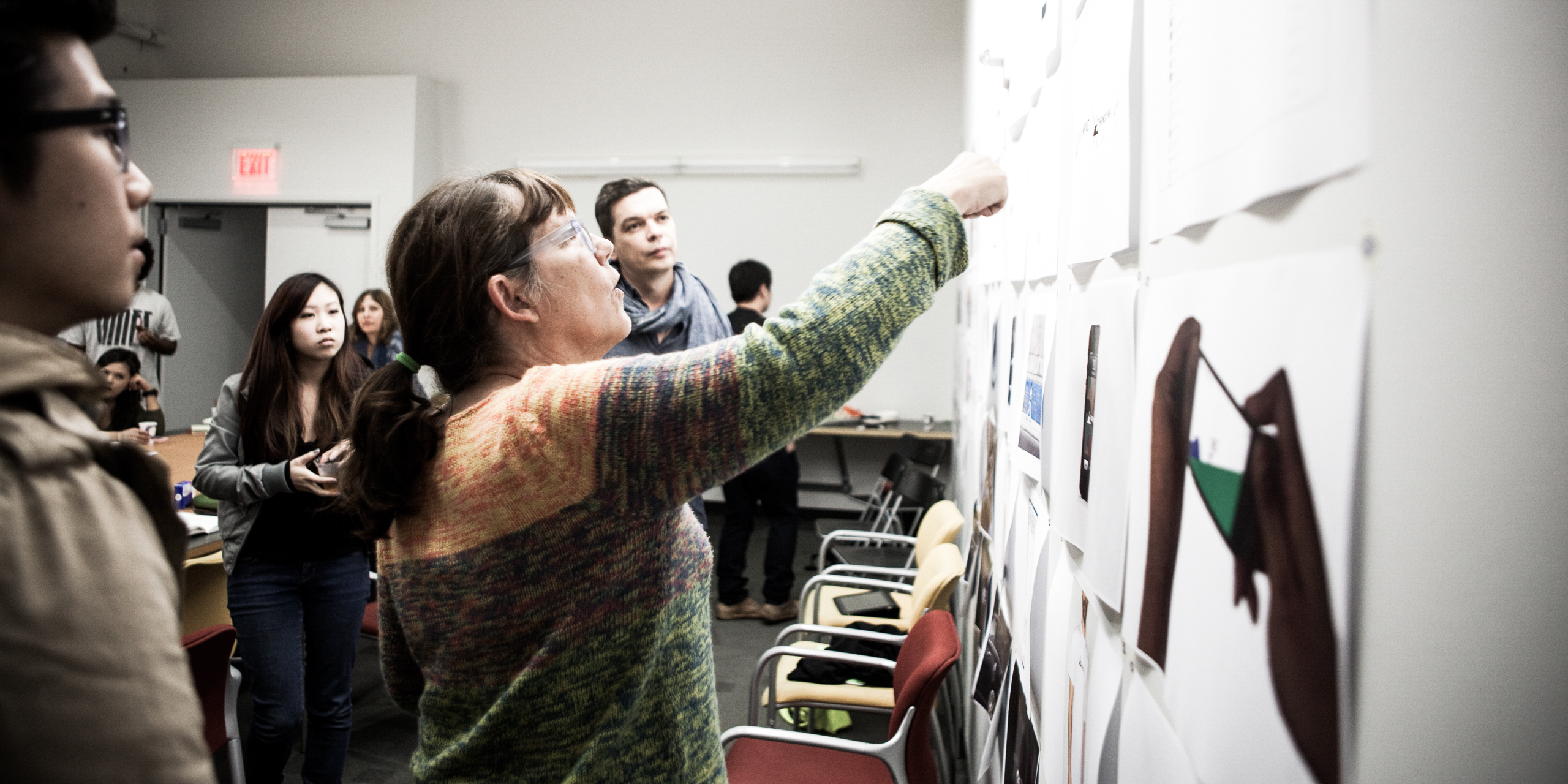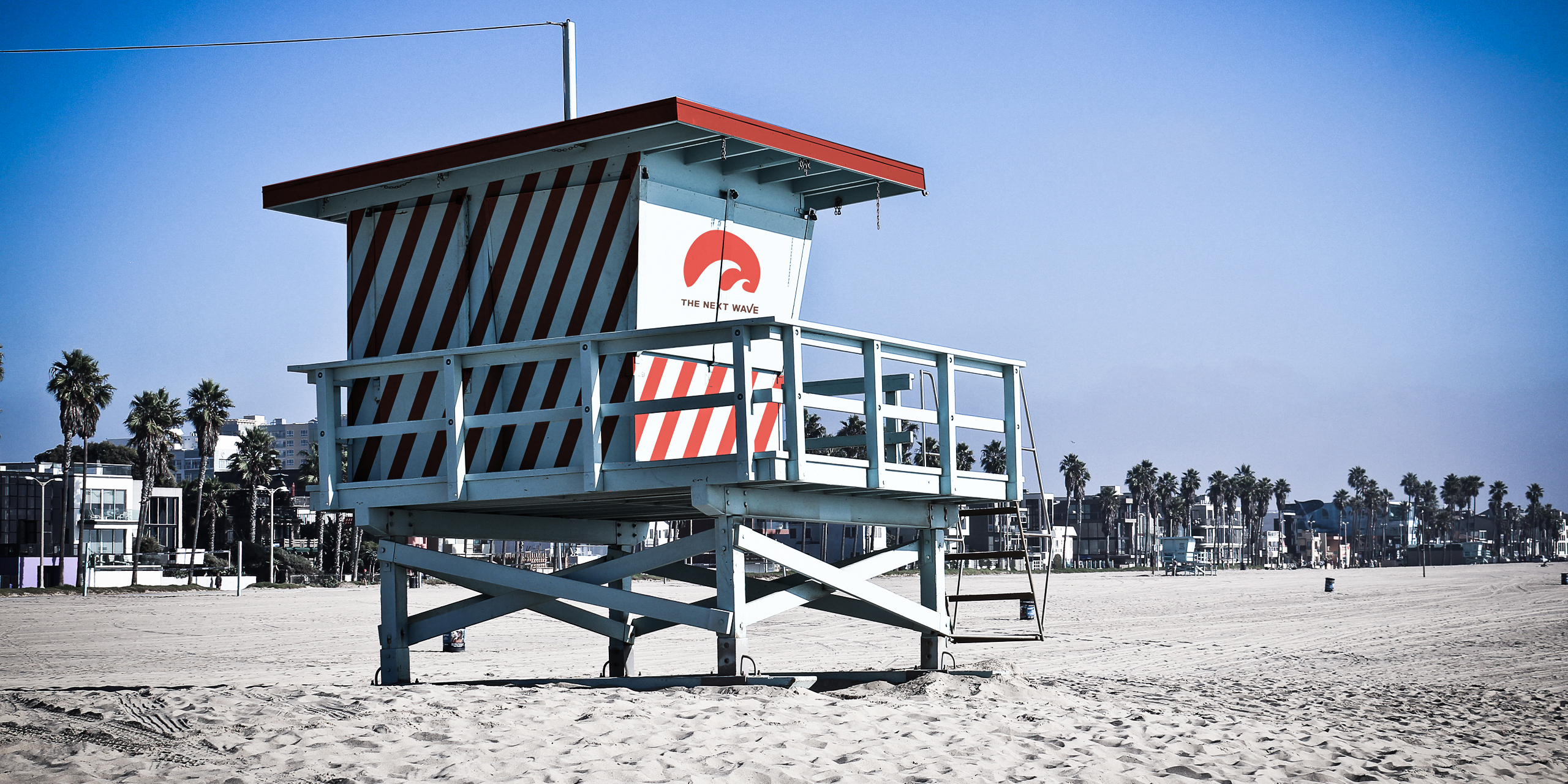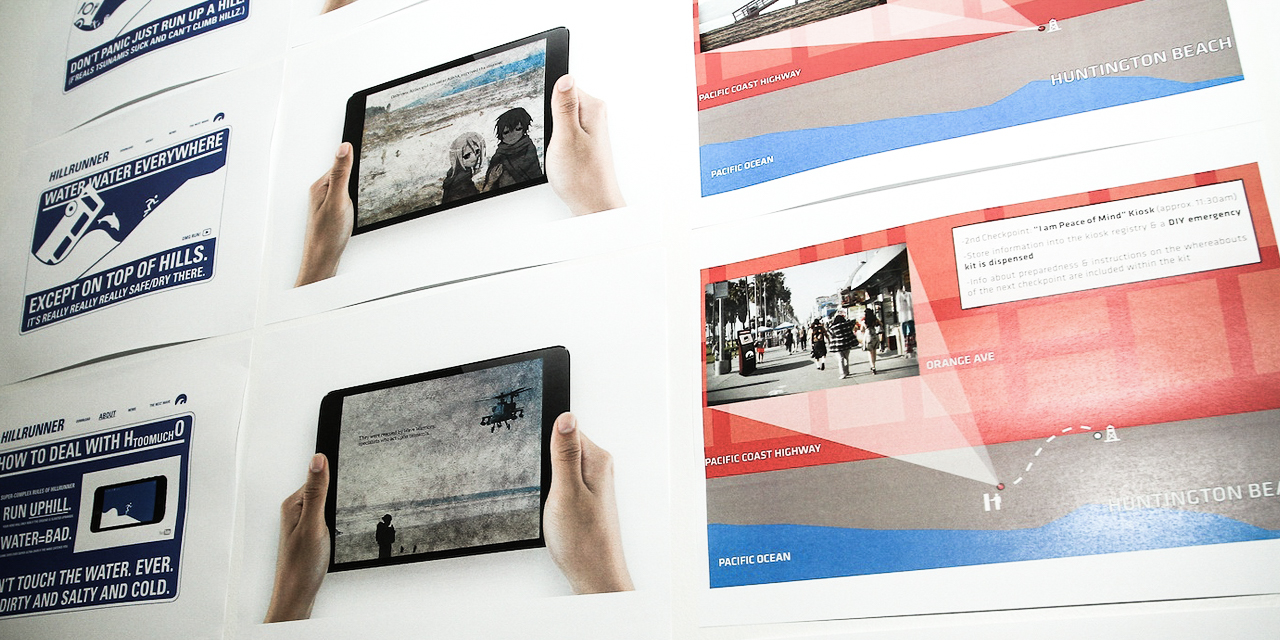The Next Wave
- Public Policy
- Sustainable Development

Fall 2012
In the fall of 2012, students in this Trans-Disciplinary Studio addressed the vital need for the coastal communities of Southern California to have a clear and engaging message about the risks and hazards of tsunamis.
Overall there are many products relating to tsunami awareness, but something different is needed to really get through to most people.
– Sue Perry, Staff Scientist, Natural Hazards Mission Area SAFRR Project, US Geological Survey (USGS)
Background
A tsunami is a series of waves, or surges, most commonly caused by an earthquake beneath the sea floor. An unusual lowering of ocean water, exposing the sea floor, is a warning of a tsunami; referred to as a “draw back,” it means the water will surge back strongly. Beaches, lagoons, bays, estuaries, tidal flats and river mouths are the most dangerous places to be when this occurs, rarely, however, does a tsunami move inland more than a mile.
Tsunami waves are unlike normal coastal waves. More like a river in a flood, or a sloping mountain of water, tsunamis are filled with debris and can break gas lines, disrupt factory operations and cause fires. Even when there is little noticeable surge, tsunamis can cause destruction. This is due to the currents they cause, which are often barely detectable until they relocate ships and impact infrastructure. Rather than looking like the kind of wave a surfer would ride, a tsunami “wave” looks more like a storm surge. Large tsunamis may reach heights of twenty to fifty feet along the coast, and even higher in a few locales, and since the surge recedes with almost as much force as when it enters, it causes destruction coming and going. It is not possible to predict how many surges, or how much time will elapse between waves for a particular tsunami. What is known is that most tsunamis have more than one surge in a single location, and can continue over hours or days. Also, the first tsunami surge is not the highest, and the largest surge may occur hours after the first wave.
Misconceptions surround tsunamis, two common ones are: if you feel strong shaking, head for higher ground immediately, and, the tsunami will arrive in moments. The truth, however, is different because, not all tsunamis are heralded by shaking, and a tsunami will not arrive in moments; 10-15 minutes will elapse between the shaking and the arrival of the first surge.
There are 5000 tsunami evacuation signs in California. As the entire California Coast is vulnerable to tsunamis, the only guaranteed way for individuals to protect themselves is to get to higher ground. If that cannot be achieved, the best alternative is “vertical evacuation,” meaning: go up in a building.
I like the idea of designing for a better purpose, which to me means using my design skills to influence change. It’s no longer about me, but about them. In this case the “them” are the people who live in or visit Southern California’s coastal cities.
– Paola Meraz, Student, Graphic Design
Design Brief
Hosted by the Graphic Design Department, this studio challenged its students to create an integrated and full spectrum awareness and education campaign around the plausible possibility of a west coast tsunami. Working in collaboration with the U.S. Geological Survey (USGS), the students focused their attention on the acute dangers and threats associated with a tsunami, if it were to strike Southern California.
The trans-media, social campaign asked students to concentrate their focus on what engages the attention of today’s contemporary audience. Addressing that lead to determining the most effective manner of capturing that same audience’s attention with regard to tsunami awareness, and to do so in ways that are unique and therefore, memorable. Ultimately, the project will serve to catalyze the public’s ability to act in ways that will save lives in the event of a Southern California Tsunami.

Research and Project Development
Week One began with immersion into the project and the problem being addressed: lack of solid, tsunami awareness among Southern California’s coastal communities. To illuminate the issues the students would be addressing, as well as to field their questions, two experts from the USGS met with the class. Dr. Lucy Jones, Chief Scientist, Science Advisor for Risk Reduction, Natural Hazards Mission Area SAFRR Project, US Geological Survey (USGS) and, Sue Perry, Staff Scientist, Natural Hazards Mission Area SAFRR Project: Science Application for Risk Reduction US Geological Survey (USGS). As the students delved further into the project’s design identity, they were anchored by Jones’ and Perry’s insights regarding the Tsunami scenario and its scope.
The Next Wave project is about designers as super heroes. We called on students to solve a problem, one that was immediate and urgent, one where they had to focus and find an answer.
– Guillaume Wolf, Faculty, Graphic Design
Week Three brought a second expert panel created to further the students’ research, and expand their knowledge of Tsunamis, both generally, as well as specific to Southern California. Students developed a broader context for their developing projects, while at the same time gained insights into the very focused tsunami scenario in Southern California. The expert panelists were comprised of: Sue Perry, USGS, Pat Lynett USC Geology Dept., Kate Long, California Emergency Management Agency (Cal EMA) Earthquake and Tsunami Program Deputy, Katherine Thompson, PhD candidate, Columbia University and Erik Bolt, NOAA: National Oceanic and Atmospheric Administration (Atmosphere section.)
Pat Lynett shared his perspective on tsunamis by detailing their two main forces: wave impact and drag force. He explained their overwhelming strength by comparing them to the forces of hurricanes and tornados, and described a tsunami’s ability to create eddies that spin around and create whirlpools, so powerful they break moorings, and pick up and move very large objects, I.e.: nuclear submarines and container ships, as large as three city blocks in length.
Kate Long’s focus was on taking the available scientific information and turning it into an actionable outcome. The threat of tsunamis is new, psychologically, to the public, and so the need for a strong public education component is enormous. To reach the public, to claim their interest, and to have them remember necessary safety information, is an ongoing fight. Long believes this is a fight that must be won, if changing in the public’s behavior in the face of a Tsunami is to be achieved, and lives saved.
Katherine Thompson discussed the psychological and social aspects of tsunami messaging. Her presentation centered around: how people think, how they take in messaging, and how they react to information. Thompson discussed issues, including, the need for tiered actions vs. single actions, gain vs. loss framing, which calls for addressing issues through a positive approach, the public’s propensity towards misconstruing and misusing probabilities, and values based messaging, in which people are motivated by goals that are relevant to them.
To create awareness about tsunamis, to be a part of class where you can all work together and create a movement, it’s a rare opportunity.
– Lena McSweeney, Student, Graphic Design

As a warning conditions forecaster for NOAA, National Oceanic and Atmospheric Administration, Eric Bolt spoke on official monitoring and warnings for tsunamis. He underscored the need to de-emphasize the arrival time of a tsunami, and instead, emphasize the possibility that a tsunami might arrive many hours later. Additionally, Bolt discussed what he called the “big Hawaii 5-0 giant, curling wave,” which will not happen in Southern California. Therefore, the real danger is that people will go to the beach to see the wave, when they should be going the other way. When they see the damage from the first (or second) wave, they will believe the danger has passed, and go down to the beach; that’s when lives are lost, as people are caught in the third, and subsequent waves. Bolt detailed three different types of alarms put out by NOAA when there is a 7.0 earthquake or above:
1. A Watch: The potential exists for something to happen later.
2. An Advisory: Something is going to happen, the threat is imminent, however it is a lower level event and will not have significant inundation. The key here is to stay out of the water, as currents will be dangerous.
3. A Warning: This will cause real threat to life and/or property. The risk level is high and the public should take cover. At this level, police officers will be placed to direct people into, or out, of areas.
The class worked collectively for the first seven weeks, during the brand exploration and positioning phase. During this time period, small teams, of three-five people, formed organically.
Week eight brought about two distinctly different approaches, and with that came self-dividing decisions, which lasted for the duration of the class. One team chose as its focus a traditional campaign, via traditional media. This approach was practical, and sought to determine what could be done immediately, in the present. Its focus was on the continued development of branding and social media initiatives. The second team’s approach was digitally based, and it focused on interactive and narrative. With its purpose set on what could be done in the future, it featured twelve touch points that related back to activating the brand, and reaching the users who were targeted.
Further research led both teams to thoroughly investigate their audiences. They sought answers that would inform them as to who is at greatest risk in the event of a tsunami. Through their research, they determined this group to include: permanent coastal dwellers, coastal businesses and visiting beach goers; from there, determination of a communication strategy began to form. Ideas and products the teams were developing were constantly evolving and highly original; one was a “Hotel TV” movie that would run approximately 1-minute in length, be non-threatening to the hotel guest, and serve as a calling card to open a conversation with the hotel industry. Additionally, at this point in the process, messaging products were being investigated; these products would serve to better communicate the tsunami issues, that through their research, the students saw were repeatedly misunderstood and/or misinterpreted.
Both approaches were united by their vision of key messaging and target audiences, with both striving to communicate to a general, non-technical, non-specialized audience. Mindful of this goal, the teams began creating deliverables that included a comprehensive brand bible, comprised of: style guide, brand narrative, social/ participatory platforms, website/utilitarian assets, mobile/tablet apps, print/ apparel/out-of-home, and disruptive/guerilla tactics. All the components needed to tie back to the brand, as well as to the narrative space, and all needed to strike a balance between the utility of things and future forward thinking, from which the client would sample.
It was vital to find the right, common tonality for this project. While the multiple appendages could have different interconnected feels, ‘The Next Wave’ would succeed only if the approaches were supported by a spine that was congruent throughout.
– La Mer Walker, Faculty, Advertising and Graphic Design
Outcomes
Traditional Media
Design Team: Salene Jang, Rhanhee Kim, Lena McSweeney, Paola Meraz, Emmily Shaw
Team One made the decision to produce a campaign to bring to people living at beach communities, and/or visiting those communities. While such a campaign already existed, Team One chose to redesign all of its elements to make its message more clear, more compelling, and ultimately, highly memorable.
Setting out to achieve these goals, the team started with a redesign of the logo. Their concept is based on the name, The Next Wave, and their logo expressed the idea that in a tsunami, it is not the first wave that does the most damage, it is the next wave that does. Visually, the “v,” in the word “wave” is moving upwards, mirroring messaging that is telling people to take the same action in a tsunami: move upwards. The second aspect of the “v,” is as a check. Representing a positive point, it is as if the public is saying, “Yes, I’m ready to face this, check.”
Supported by what they determined to be two psychological triggers: empowerment and feeling safe, the group created two campaigns. The first was photography based, and its focus was empowerment; the second campaign was pictogram based, its characters were recognizable and playful, growing out of people living around the beach. The pictograms focused on feeling safe, and the idea that, as a community, we feel safe.
The phrase, “Know the Tsunami” was integral to the messaging, and grew out of the team’s desire to educate the public regarding the confusing and deceptive type of danger that define tsunamis. They felt that knowledge was key, and the information they wanted to impart was for people to realize that there is more after the first wave, that it will be the next wave, which will have greater potential to hurt them. Their “Know the Tsunami” tagline is powerful; it gives relevant information in a way that is playful, and that leads to engagement and discovery.
Collateral for both photography and pictograms featured: billboards, bus ads and bus stop posters, tee shirts, surfboards, skateboards, car decals, buttons, pins, mall displays, and prominent displays on lifeguard huts across Southern California’s beaches. Additionally, both campaigns featured a notebook, to be distributed to the public, with its first pages devoted entirely to information regarding what to do in the event of a tsunami. Team One also created a unique tote bag. Its tsunami messaging was on the inside, and was revealed almost as if by telling a (written) secret, once the logo on the outside, grabbed people’s attention. The tote bag would be distributed at beach events. The idea behind it being that individuals would use it as their beach bag in the future, and with its important information inside, they would know how to be safe in a tsunami.
Finally, Team One developed a pamphlet as a deliverable. Initially small in size, the pamphlet next opened to a larger size to reveal two additional pieces of information, when opened further, more information was dispensed, until fully opened, when a photograph became visible. This photograph was in keeping with the psychological trigger of “empowerment.” Alternately, the fully opened pamphlet could also reveal a pictograph congruent, to the “feeling safe” message.

A lot of people in southern California don’t know about tsunamis; I’m from the Philippines, so personally, I’m hyper aware of what people need to know in order to be safe from tsunamis. This class let me put what I know into action, and I hope maybe help save lives
– Ivhan Escudero, Student, Graphic Design
Outcomes
Digital + Interactive
Design Team: Joe Chang, Abraham Chuang, Ivhan Escudero, Renee Kim, Luna Lie, Janya Menges, Gabriel Moise, Tiffany Tsai
With regard to awareness of tsunami dangers, Team Two focused their work on changing the public’s statement, from, “I don’t know what to do,” to, “I knowexactly what to do.” They chose to not use an authoritative voice, rather, they opted for a form of message dispersal in which a few people would be told, and they would tell a few others, with the message continuing outward in that manner. Twelve interactive touchpoints were developed to reach that goal; these multiple channels of communication all created momentum toward the brand. A Branding Hub let people see all twelve touchpoints at once, and also connected to each individual touchpoint.
12 Touchpoints:
Current: A live, global feed on tsunamis and earthquakes. Current has features that let the user navigate through a variety of different points.
Sonar: This micro-platform allows people to connect within their communities. It contains stories, projects, and different ways for people to join together and explore.
Frequency: A news media aggregator, Frequency lets the public see the information it features with ease. Operating much like Facebook, Frequency lets people customize the look and feel of their sites, but in order to do so, they must first watch a short film explaining what to do should a tsunami strike. In the event of an actual earthquake and subsequent tsunami, Frequency alerts the public.
Bundle: Developed as an e-commerce site, Bundle would sell Tsunami Emergency Kits. Three different kits would be for sale: for the home, for the office, and for the car.
Source: This touchpoint strives to communicate information through a strong graphics approach. It features a timeline, which individuals could click on for past tsunami information, and would also have a live feed.
Swell: An interactive infographic, Swell makes its point that: small waves can still create great damage, by letting the user control a tsunami wave as it moves outward from the ocean, to the shore, and through Venice, California.
Hillrunner: This game was developed as an app for iPhones and other smart technology. The game would be free.
Academy: A graphic novella, Academy would be a short story developed for the iPad. The story features a “Wave Warrior” attending the “Next Wave Academy.” As the warriors are trained to prepare for the Next Wave, they learn things like: how to get to higher ground, and how to save lives.
Buoys: Made for Twitter, these tsunami watch buoys have two strongly individual personae. With the purpose of simply entertaining the public, their “hash tags” always lead back to the Next Wave: #nextwave.
Surge: Through a character from a Cartoon Network television program, Surge, attracts a younger audience and gets them involved in The Next Wave by teaching through games.
Beacon: This touchpoint is a YouTube page serving as an archive and link for all other sites that the class has developed. Beacon also has interactive characters, links, and videos on tsunamis.
The Watch: Designed to be a Next Wave product site, currently, it features tee shirts and an actual watch for surfers and beachgoers, which provides information and alerts about tidal activity and tsunamis around the world.
The Clash: This would be an outdoor event/competition where participants are rewarded at the end of each task or mission completed. During The Clash, participants learn tsunami safe routes and other key tsunami message points. For those unable to participate, a home version of The Clash would be available.
The Hidden Project: An ARG (Alternate Reality Game), The Hidden Project would take place outdoors with players competing to win the game. While doing so, the game would raise participants’ tsunami awareness in a fun, positive way. Starting at a lifeguard stand, The Hidden Project alerts players to a virtual tsunami that is coming. To survive, players would find clues that take them to a number of checkpoints leading to the final checkpoint/destination: a music event.
In addition to the Touchpoints, a Next Wave Branding Kit was developed, featuring: a brochure, safe zone maps, wallpaper, social media kit, posters, small business kit, home kit, hotel travel kit, and has “like” buttons for Facebook.

Latest News
![2014_poster[2]](https://designmattersatartcenter.org/wp-content/uploads/2014_poster2-194x300.png) Between 2013-2014, a motion/film piece component to this campaign was developed and finalized by a special section of Digital Motion Compositing, under the leadership of Instructor Ming Tai. Detail on that process and outcomes can be found at the Next Wave: Know the Tsunami. In Spring 2014, Art Center Graphic Design and DM Concentration graduate Heather Grates was hired by USGS to extend the Next Wave brand into new materials for the National Tsunami Hazard Mitigation Program, for use by communities and organizations who are staging public tsunami drills in 2014 as part of the 50th anniversary of the 1964 Alaskan “Good Friday” earthquake and tsunami. These new materials will be used by National Weather Service, the National Oceanic and Atmospheric Administration (NOAA) and others throughout the year.
Between 2013-2014, a motion/film piece component to this campaign was developed and finalized by a special section of Digital Motion Compositing, under the leadership of Instructor Ming Tai. Detail on that process and outcomes can be found at the Next Wave: Know the Tsunami. In Spring 2014, Art Center Graphic Design and DM Concentration graduate Heather Grates was hired by USGS to extend the Next Wave brand into new materials for the National Tsunami Hazard Mitigation Program, for use by communities and organizations who are staging public tsunami drills in 2014 as part of the 50th anniversary of the 1964 Alaskan “Good Friday” earthquake and tsunami. These new materials will be used by National Weather Service, the National Oceanic and Atmospheric Administration (NOAA) and others throughout the year.
